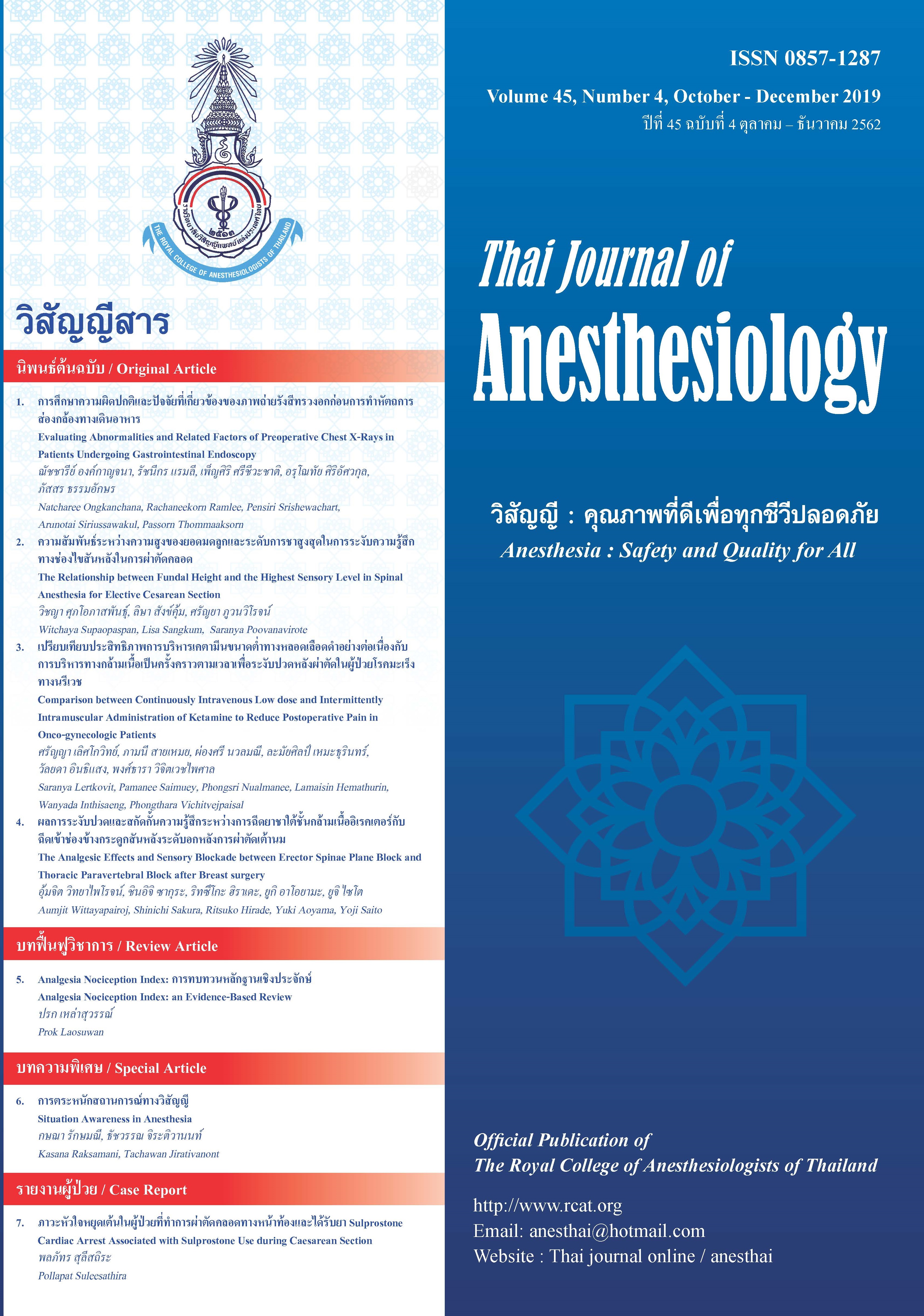The Relationship between Fundal Height and the Highest Sensory Level in Spinal Anesthesia for Elective Cesarean Section
Main Article Content
Abstract
Background: Spinal anesthesia is the most popular
choice for elective caesarean section for several reasons.
The analgesic level that is too high can cause some
adverse events such as hypotension, nausea, chest
discomfort. Therefore knowing the factors affecting the
analgesic level can help anesthesiologist in adjusting the
dosage of local anesthetic in each parturient.
Objectives: This study will look through whether the fundal
height correlates with highest sensory level and also find
the correlation between the fundal height and ephedrine
consumption.
Methods: A prospective observational study was
conducted in fifty-three uncomplicated parturients who
scheduled for elective cesarean section. Before spinal
anesthesia was administered, all parturients had been
measured for symphysis-fundal height (SFH) and
symphysis-xiphoid height (SXH). Afterwards, SFH and
SXH were calculated to find the percentage of SFH/SXH
ratio. Percentage of SFH/SXH ratio will represent the
uterine size. The sensory level and the amounts of
ephedrine to treat hypotension were recorded every
2 minutes until 15 minutes after blockage. Correlation
analysis was applied to find the correlation between the
percentage of SFH/SXH ratio and the highest sensory
blockage, and between the percentage of SFH/SXH ratio
and ephedrine consumption.
Results: There was no significant correlation between
percentage of SFH/SXH and highest sensory level
(r=0.068, p-value = 0.065), and no significant correlation
between the amounts of ephedrine and percentage of
SFH/SXH (r=0.09, p-value = 0.102).
Conclusions: In term parturients undergo elective
cesarean section under spinal anesthesia, the fundal
height has no correlation with highest sensory level and
ephedrine consumption.
Article Details
References
cesarean delivery at a tertiary care hospital from 2000 to
2005 : a retrospective analysis and –10 year update. Int J
Obstet Anesth 2011;20:10-6.
2. Tsen LC. Anesthesia for cesarean delivery. In : Chestnut DH,
Wong CA, Tsen LC, Ngan KEE WD, Beilin Y, Mhyre JM.
Chestnut’s Obstetric Anesthesia. 5thed. Philadelphia: Mosby
Elsevier; 2014. p 545-603.
3. Birnbach DJ, Brown IM. Anesthesia for obstetrics. In: Miller
RD, Eriksson L, Fleisher L, Wiener-Kronish JP, Young WL.
Miller’s Anesthesia.7thed. Philadelphia: Churchill Livingstone.
2010. p 2203-40.
4. Norris MC. Height, Weight, and the spread of subarachnoid
hyperbaric bupivacaine in the term parturient. Anesth Analg
1988; 67:555-8.
5. Chung SH, Yang HJ, Lee JY, et al. The relationship between
symphysis-fundal height and intravenous ephedrine dose in
spinal anesthesia for elective cesarian section. Korean J
Anesthesiol 2010;59(3):173-8.
6. Ostle B, Malone LC. Statistics in research: Basic concepts
and techniques for research workers. 4th ed. Ames: Iowa
State University Press. 1988. p234..
7. Hartwell BL, Aglio LS, Hauch MA, et al. Vertebral column
length and spread of hyperbaric subarachnoid bupivacaine
in the term parturient. Reg Anesth 1991;16(1):17-9.
8. Harten JM, Boyne I, Hannah P, Varveris D, Brown A. Effects
of a height and weight adjusted dose of local anaesthetic for
spinal anaesthesia for elective caesarean section. Anesthesia
2005;60:348-53.

